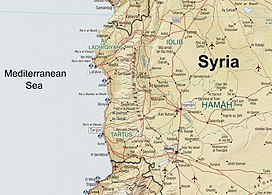Syrian Coastal Mountain Range
| Syrian Coastal Mountain Range | |
|---|---|
| سلسلة الجبال الساحلية | |
 Coastal Mountain Range | |
| Highest point | |
| Peak | Nabi Yunis |
| Elevation | 1,562 m (5,125 ft) |
| Dimensions | |
| Length | 150 km (93 mi) |
| Geography | |
| Location | Syria |
| Range coordinates | 35°36′N36°14′E/ 35.60°N 36.24°E |
TheCoastal Mountain Range(Arabic:سلسلة الجبال الساحلية,Silsilat al-Jibāl as-Sāḥilīyah) also calledJabal al-Ansariya,Jabal an-NusayriaorJabal al-`Alawīyin(Ansari, Nusayri or Alawi Mountains) is a mountain range in northwesternSyriarunning north–south, parallel to the coastal plain.[1]The mountains have an average width of 32 kilometres (20 mi), and their average peak elevation is just over 1,200 metres (3,900 ft) with the highest peak, Nabi Yunis, reaching 1,562 metres (5,125 ft), east ofLatakia.[1]In the north the average height declines to 900 metres (3,000 ft), and to 600 metres (2,000 ft) in the south.
This mountain range has been home to anAlawite populationsince theMiddle Ages.[2]
Name
[edit]Classically, this range was known as theBargylus,[3][2]a name mentioned byPliny the Elder.[4]TheGreek:Μπάργκυλος,romanized:Bargylus) had its roots in the name of an ancient city-kingdom calledBargamost probably located in the vicinity of the mountains;[5]it was a city of theEblaiteEmpire in the third millennium BC,[6]and then a vassal kingdom of theHittites,[7]who named the mountain range after Barga.[8]
In the medieval period were known as theJabal Bahra(جبل بهراء) after the Arab tribe ofBahra’.[9]They are also sometimes known as theNusayriyah Mountainsor theAnsarieh Mountains(جبال النصيريةJibāl an-Nuṣayriyah) or theAlawiyin Mountains(جبال العلويينJibāl al-‘Alawīyin); both of these names refer to theAlawiethnoreligious groupwhich has traditionally lived there, though the former term is based on anantiquated labelfor the community that is now considered insulting.
Geography
[edit]The western slopes catch moisture-laden winds from theMediterranean Seaand are thus more fertile and more heavily populated than the eastern slopes. TheOrontes Riverflows north alongside the range on its eastern verge in theGhab valley,a 64 kilometres (40 mi)longitudinal trench,[10]and then around the northern edge of the range to flow into the Mediterranean. South ofMasyafthere is a large northeast-southweststrike-slip faultwhich separates An-Nusayriyah Mountain from the coastalMount Lebanonand theAnti-Lebanon MountainsofLebanon,in a feature known as theHoms Gap.[1]
Between 1920 and 1936, the mountains formed parts of the eastern border of theAlawite Statewithin the FrenchMandate for Syria and the Lebanon.
See also
[edit]References
[edit]- ^abcFederal Research Division, Library of Congress (2005)"Country Profile: Syria"(PDF), page 5.
- ^abMillar, Fergus (1995-03-15).The Roman Near East: 31 BC–AD 337.Cambridge, Massachusetts: Harvard University Press. p. 17.ISBN978-0-674-77886-3.
These limestone hills rising to some 1500 m, the ancient Mons Bargylus or present Jebel Ansariyeh, inhabited by an Alawi population since the Middle Ages, have never been open to archaeological investigation, and remain an almost complete blank in the archaeological and social map of the region.
- ^Hackett, Horatio B. (editor) (1870)Dr. William Smith's Dictionary of the Bible: comprising its antiquities, biography, geography, and natural history(Volume IV, Regum-Melech to Zuzims) Hurd and Houghton, New York,page 3142,OCLC325913985
- ^William Smith (1857).Dictionary of Greek and Roman Geography: Iabadius-Zymethus.Little, Brown and Company. p.1071.
- ^Forrer, Emil Orgetorix Gustav (1928). "Barga". In Ebeling, Erich; Meissner, Bruno (eds.).Reallexikon der Assyriologie(in German). Vol. 1. Walter de Gruyter & Co. p. 401.OCLC718866.
- ^Cyrus Herzl Gordon; Gary Rendsburg; Nathan H. Winter (2002).Eblaitica: Essays on the Ebla Archives and Eblaite Language, Volume 4.p. 121.ISBN978-1-57506-060-6.
- ^Gordon Douglas Young (1981).Ugarit in Retrospect: Fifty Years of Ugarit and Ugaritic.p. 227.ISBN9780931464072.
- ^James Orr (1930).The International Standard Bible Encyclopaedia.Vol. 3. p. 1400.
- ^Salibi, Kamal (2005).A House of Many Mansions: The History of Lebanon Reconsidered.Londo: I. B. Tauris.ISBN1860649122.
- ^Encyclopædia Britannica – Syria
